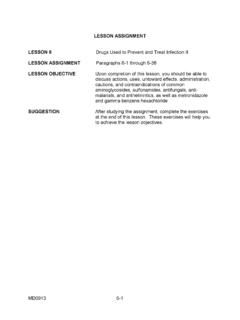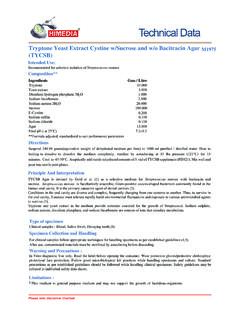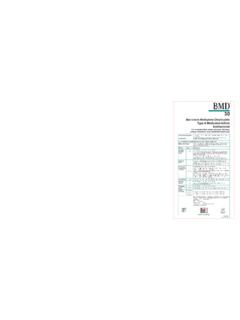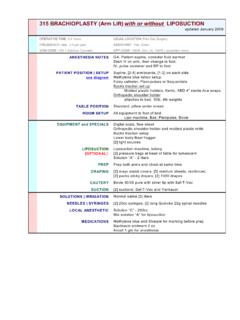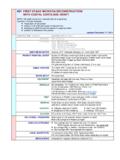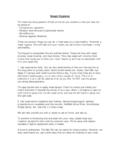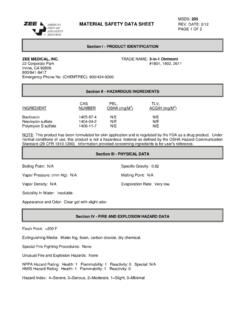Transcription of Arizona Sinus Center
1 Nasal Cautery Arizona Sinus Center Phone (602) 258-9859 Fax (602) 256-0820 Instructions following Nasal Cautery to control nosebleeding Supplies for home: Nasal Saline Spray (Ocean , Deap Sea , etc.) Antibiotic ointment (Mupirocin, Bacitracin or Neosporin ) Nasal decongestant spray (Neosynepherine or Afrin ) Neil Med Sinus Rinse Small room air humidifier or vaporizer for the bedside Cotton balls General: Cauterization of the nose is performed to control recurrent or troublesome, mild to moderate nosebleeds. This can usually be performed safely and comfortably in the office under local or topical anesthesia (numbing medicine is placed into the nose and the patient remains awake during the procedure). Silver nitrate is conservatively applied to the source of bleeding with a Q-tip -like applicator. This causes a mild chemical burn which seals the bleeding vessels and triggers scar tissue formation. The layer of scar tissue helps prevent future bleeding from that site.
2 Alternatively, for severe bleeding, an electrocautery instrument is used to cauterize the tissue while the patient is under general anesthesia (completely asleep). Diet: There are no dietary restrictions following nasal cautery. Pain control: Patients report mild nasal pain or burning for a few to several days following cauterization. This is usually well controlled with Tylenol as directed or relieved by spraying the nasal passages with saline solution. Please contact our office (602) 258-9859 if your pain is not controlled with Tylenol. Activity: No heavy lifting, straining or vigorous cardiovascular exercise for 1 week following the nasal cautery. Any activity in which the nose may be manipulated could cause re-bleeding from the cauterized area during the first 7-10 days. Nasal care following the procedure: Spray the cauterized nasal passage 8-10 times daily with nasal saline (Ocean , Deap Sea or generic equivalent) beginning the morning following the procedure.
3 Two to three sprays should be applied each application. Your doctor may also recommend that you rinse the nasal passages with a Neil-Med Sinus Continued on back Rinse bottle (available over the counter at most pharmacies) or a netti-pot once to twice daily. Gently apply a layer of antibiotic ointment to the cauterized side of the nasal septum (internal middle wall separating the nasal passages) twice daily for the first week. This is accomplished by washing the hands thoroughly with soap and water, placing a pea-sized amount of ointment onto the pinky finger and massaging the ointment onto the septum. Pinch the nostrils together gently to circulate the ointment further back into the nose. Hot steam showers as needed are very helpful in relieving nasal congestion and crusting. Your doctor may have you spray your nose with decongestant spray (Afrin or Neosynepherine) as needed for persistent nasal congestion and oozing. A scant gray residue may temporarily stain the skin of the nostril or upper lip.
4 This is from the silver nitrate and generally fades in about 1 week. Gently wiping any gray residue from the nostril opening will avoid this staining. What to do if bleeding starts again: Spray the bleeding nostril with 2 squirts of Neosynepherine or Afrin spray (both are available over-the-counter). Soak a cotton ball with the spray. Stuff the cotton ball into the front of the bleeding nasal passage. Pinch the nostrils together against the septum (between your thumb and index finger, also pinching the cotton ball in the nose). Hold this pressure for 15 minutes without checking. If bleeding is stopped when you release pressure, keep the cotton ball in place for 30 more minutes then remove gently. If bleeding is persistent during holding pressure then proceed to the nearest emergency room. If the bleeding persists only when you release the pressure, repeat the cycle with the holding pressure and the cotton ball in place up to 3 times.
5 If bleeding is persistent despite this regimen, please call the office at (602) 258-9859. Follow-up appointment: Your follow up appointment in the office will be 2-4 weeks following your procedure to ensure the cauterized nasal tissue is healing well. Office phone: (602) 258-9859 Website.
